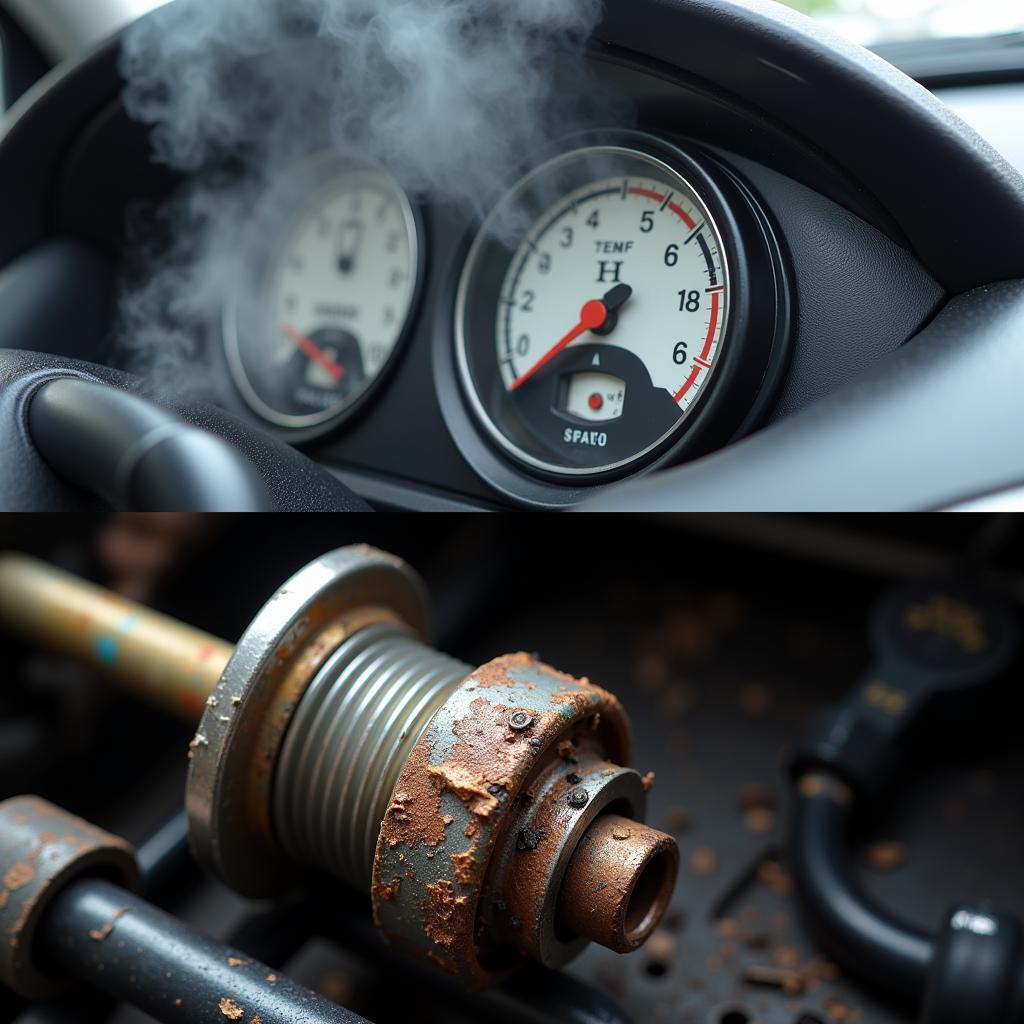Car Thermostat Problems Symptoms can range from subtle to severe, impacting your vehicle’s performance and potentially leading to costly repairs. Understanding these symptoms is crucial for early diagnosis and preventing further damage. In this guide, we’ll explore the most common car thermostat problems symptoms, their causes, and effective solutions.
Recognizing the Telltale Signs of Car Thermostat Problems
A faulty thermostat can disrupt your engine’s optimal operating temperature, resulting in various noticeable symptoms. Overheating is a primary indicator, often accompanied by a temperature gauge reading higher than normal. However, a stuck-open thermostat can also cause the engine to run too cold, leading to poor fuel economy and increased emissions. car thermostats problems often manifest in inconsistent temperature readings.
Other car thermostat problems symptoms include:
- Fluctuating temperature gauge: The needle might swing erratically between hot and cold, indicating the thermostat’s struggle to regulate temperature.
- Heater malfunction: A faulty thermostat can prevent the heater from producing sufficient heat, leaving you shivering on cold days.
- Coolant leaks: While not directly caused by a thermostat issue, leaks can exacerbate existing problems and lead to overheating, which can damage the thermostat.
- Sudden loss of power: In extreme cases, a severely malfunctioning thermostat can trigger a failsafe mode, limiting engine power to prevent catastrophic damage.
 Car Overheating Due to Faulty Thermostat
Car Overheating Due to Faulty Thermostat
Diagnosing and Fixing Car Thermostat Problems
Diagnosing car thermostat problems requires a systematic approach. Start by visually inspecting the thermostat housing for leaks or damage. Next, check the coolant level and condition. Low coolant or dirty coolant can contribute to overheating and other thermostat-related issues.
A simple test involves starting the engine and feeling the upper and lower radiator hoses. If the upper hose heats up quickly while the lower hose remains cold, it suggests a stuck-closed thermostat, preventing coolant circulation. car thermostat temp problems can often be confirmed with this test.
Replacing a faulty thermostat is a relatively straightforward procedure for most vehicles. It typically involves draining the coolant, removing the thermostat housing, installing the new thermostat, and refilling the coolant. However, for some complex engine layouts, professional assistance may be necessary.
What is the Most Misdiagnosed Car Overheating Problem?
Often, a failing water pump is misdiagnosed as a thermostat issue. Both can cause overheating, but a faulty water pump won’t circulate coolant effectively, even with a functioning thermostat. Proper diagnosis is crucial to avoid unnecessary repairs. what is the most misdiagnosed car overheating problems can help you avoid common misdiagnosis.
“A common mistake is assuming overheating always points to a bad thermostat,” says automotive expert, Robert Hernandez. “A thorough inspection is vital to identify the root cause, whether it’s a faulty water pump, clogged radiator, or indeed, a thermostat problem.”
Preventing Car Thermostat Problems
Regular maintenance is key to preventing car thermostat problems. This includes:
- Flushing the coolant system: This removes debris and contaminants that can hinder thermostat operation and clog the cooling system.
- Checking the coolant level: Maintain the correct coolant level to prevent overheating and ensure proper thermostat function.
- Inspecting the thermostat housing: Look for leaks or cracks in the housing that can lead to coolant loss and overheating.
nissan sentra car problems can sometimes include thermostat issues. Likewise, my summer car engine problems can be related to the thermostat.
“Preventive maintenance is the best way to avoid costly repairs down the line,” advises automotive engineer, Sarah Chen. “Regular checks and timely replacements can significantly extend the life of your car’s cooling system and prevent thermostat-related issues.”
Conclusion
Car thermostat problems symptoms can manifest in various ways, from overheating to poor heater performance. Understanding these symptoms is crucial for early diagnosis and preventing further engine damage. By following the tips outlined in this guide, you can maintain a healthy cooling system and ensure your vehicle runs smoothly. If you need assistance, don’t hesitate to connect with AutoTipPro. Our contact information is: Phone: +1 (641) 206-8880, Office: 500 N St Mary’s St, San Antonio, TX 78205, United States. We are here to help!




Leave a Reply